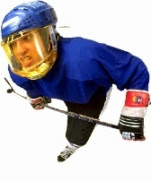Sports Dentistry
Sports Dentistry is the treatment and prevention of oral / facial athletic injuries. Dental injuries are actually the most common type of facial injuries sustained during athletic participation.
Mouthguards
A mouthguard is a plastic appliance worn in the mouth during physical activity which helps in preventing injuries to the teeth, tongue, lips and jaw. Sports related dental injuries are often very traumatic; not only are they painful, but costly as well. Mouthguards offer excellent protection at a relatively small price. No matter which variety you go with, what's important is that it fits and is comfortable.
It's estimated that an avulsed (knocked-out) tooth will run you between $10,000 -15,000 in dental bills over your lifetime. ...not to mention all those enjoyable hours in the waiting room!
The Three Types of Mouthguards
Stock Mouthguards: These are the least expensive of the group, available at most sport stores. They offer the least protection and often interfere with breathing and speaking. Manufacturers produce these in only a few sizes, even if you could try them out in the store (which we wouldn't recommend), you wouldn't find one that fit. Tooth arrangement and arch size varies too much between people. Without the recommendation of a qualified dentist, we recommend that mouthguards bought at sporting good stores should not be worn. There is just too much variability amongst dentitions for the mass-production of effective mouthguards.
Mouth-Formed (thermoplastic) Mouthguards: They're inexpensive and are carried by most sport stores. They're basically a piece of plastic which when placed in boiling water is moldable to your teeth. The plastic can be reheated and remolded if not properly made on the first attempt. People usually complain that they're too bulky and difficult to speak with, though, their fit is much better than the stock mouthguards.
Custom-Made Mouthguards: Custom-made mouth guards are produced from cast models of your mouth. They offer the highest level of fit and protection. Unlike commercial varieties, they don not interfere with speech or breathing. They're designed to cover all of the back teeth; this has a cushioning effect on blows to the jaw, often preventing concussion. Custom guards are more expensive than their commercial counterparts, but more than make up for it in the quality of their protection
What to Look for in a Mouthguard:
- Comfortable
- Easy to clean
- Provide maximum protection in the incidence of a traumatic force
- Remain in place during sports activity (stock trays are notoriously poor-fitting)
- Not interfere with speech or breathing
Caring for Your Mouthguard:
- Keep it in its container
- Rinse it off after each use
- Clean your mouthguard periodically with soap and water
Do's and Don’ts:
- If you have a mouthguard, wear it.
- Don't wear removable appliances such as retainers or dentures when playing sports.
- Get your dentist to make you a custom mouthguard if you have any crown or bridgework; protect your investment.
Mouthguard Tips:
- Usually, mouthguards should be made for the maxillary (upper) arch. If you have a Class III bite (prognathic bite/ protruding mandible), your mouthguards may have to be made for your lower jaw.
- If your child is between the ages of 6 - 12, the mouthguard should be made to allow for the eruption of permanent teeth.
- If you currently wear braces, your mouthguard should be modified by your dentist during its fabrication to allow for additional orthodontic movement.
We're out participating at educational conventions and seminars throughout the year and we'd like to use this blog as a dental resource for our community of Phoenix, AZ (and beyond). Of course, we welcome you to join the conversation. Suggest topics and ask those burning questions about dentistry that keep you up at night. Please feel free to contact me through the Morse Family Dental website. Remember, the advice provided here is intended to aid you in understanding some of the treatment options available. It is important to note that before beginning any course of treatment you should always see your dentist.
